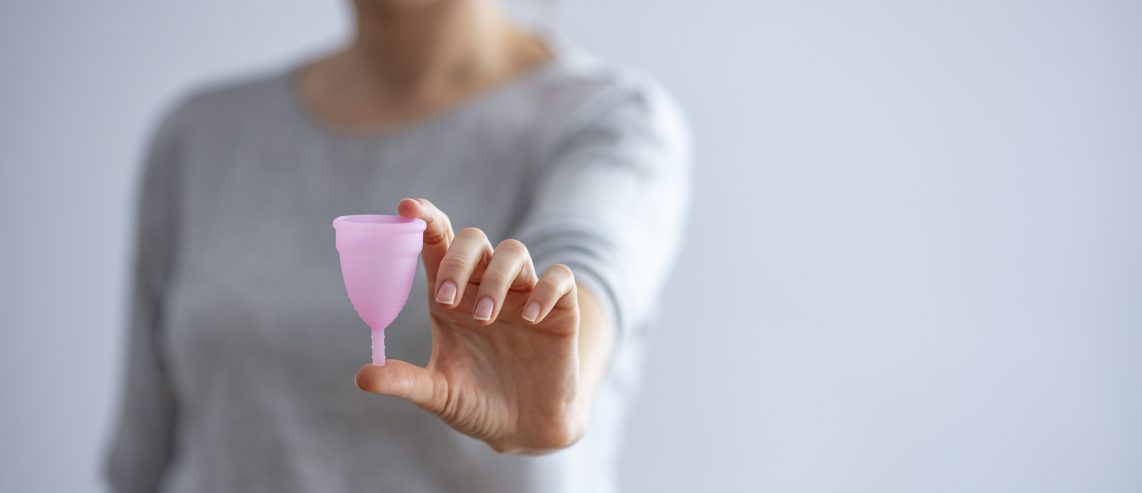A menstrual cup is a reusable cup women use to collect menstrual blood during their period. It stays in the vaginal canal, held in place by the pelvic floor muscles. There are many different brands and shapes, and the cups are typically made of medical-grade silicone, rubber, elastomer, or latex.
A menstrual disc is similar to a menstrual cup, but it is, as the name suggests, more disc-shaped. It sits higher up in the vaginal canal, right below the cervix. A menstrual disc is sometimes called a cervical cap.
Women remove menstrual cups and discs by pulling on them or using a finger to break the seal. Some cups have a stem to make removal easier. Then, women empty them into the toilet, wash them out, and reinsert them.
What Are the Advantages of Using Menstrual Cups?
Women choose menstrual cups and discs because they’re eco-friendly and cheaper than pads and tampons. If a woman used a menstrual cup for 10 years, she could save $600 to $1200. (Many menstrual cups can last up to 10 years and cost $20 to $40.)
Also, women don’t need to empty them as often as they need to change tampons or pads. Many menstrual cups and discs can provide protection for 12 hours. This is because they hold around three to six times the amount of a tampon.
Menstrual cups can be a good option for women with heavy flows. They can also work well for women who can’t change a pad or tampon several times a day, due to a job, for example.
A systematic review in The Lancet looked at 15 studies involving over 3,300 people. It found that women found that the cups didn’t leak any more than tampons or pads.
Never Miss a Beat!
Subscribe to Our HealthBeat Newsletter!
Thank you for subscribing!
You can now select the specific newsletters you'd like to receive.
You are already subscribed.
Subscribe to more newsletters in our email preference center.
Sorry, an error occurred. Please try again later.
Get Healthy Tips Sent to Your Phone!
What Are the Drawbacks of Using Menstrual Cups?
Some women find menstrual cups painful to insert because they are larger than a tampon. (They fold for easier insertion and then open up in the vaginal canal.) Some women also complain that they can be uncomfortable once they’re inserted, though this may be due to improper insertion.
Menstrual cups and discs have the potential to spill during removal. Those using cups and discs should always remove them over a toilet to avoid getting blood on clothing or other belongings.
The Lancet review found that around 11% of women no longer wanted to use the menstrual cup after a few cycles.
Are Menstrual Cups Safe?
Menstrual cups are generally safe, but rare complications can occur. The Lancet review found some women experience toxic shock syndrome (TSS) with menstrual cups. TSS is a rare infection caused by bacteria, which can build up on tampons and menstrual cups.
In the review of 15 studies, one woman had a lab-confirmed TSS infection. Four other women reported symptoms that could have been TSS.
Is TSS more or less common with menstrual cups, compared to tampons? Unfortunately, there currently isn’t enough data to say.
To prevent TSS, experts say women should always remove the cup or disc after the maximum time. Depending on the type, this may be 8 to 12 hours. Women should clean the cups and discs between each use and boil them for five to ten minutes after each cycle.
Menstrual cups can also cause rashes and irritation in people who are allergic to latex or silicone.
In rare cases, menstrual cups or discs can dislodge intrauterine devices. Planned Parenthood does not recommend using menstrual cups if you have an IUD.
The Bottom Line
Menstrual cups are safe, cost-saving, and good for the environment, but they might not be for everyone. It can take women a few cycles to get the hang of inserting and removing the cups. (Online instructional videos can help with this process.)
For those who don’t mind cleaning them, a menstrual cup or disc is worth trying. If one cup or disc shape doesn’t feel right, another one might work better. With so many different types and styles, you may eventually find one that works well for you.
Sources
Rose Evelyth. The best menstrual cup. New York Times. Link
Kathleen Newman-Bremang. All your menstrual cups questions, answered — & we mean all of them. Refinery29. Link
Planned Parenthood. What's the deal with menstrual cups? Link
Roni Caryn Rabin. A Better Way to Manage Your Period? Try the Menstrual Cup, Scientists Say. New York Times. Link
Dr. Anna Maria van Eijk et al. Menstrual cup use, leakage, acceptability, safety, and availability: a systematic review and meta-analysis. The Lancet. Link
About UPMC Magee-Womens
Built upon our flagship, UPMC Magee-Womens Hospital in Pittsburgh, and its century-plus history of providing high-quality medical care for people at all stages of life, UPMC Magee-Womens is nationally renowned for its outstanding care for women and their families.
Our Magee-Womens network – from women’s imaging centers and specialty care to outpatient and hospital-based services – provides care throughout Pennsylvania, so the help you need is always close to home. More than 25,000 babies are born at our network hospitals each year, with 10,000 of those babies born at UPMC Magee in Pittsburgh, home to one of the largest NICUs in the country. The Department of Health and Human Services recognizes Magee in Pittsburgh as a National Center of Excellence in Women’s Health; U.S. News & World Report ranks Magee nationally in gynecology. The Magee-Womens Research Institute was the first and is the largest research institute in the U.S. devoted exclusively to women’s health and reproductive biology, with locations in Pittsburgh and Erie.
